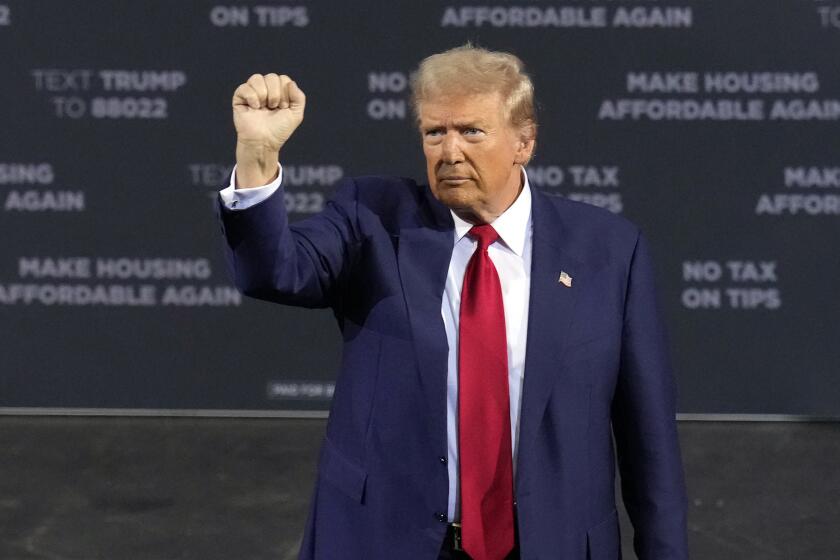Democrats Soak Up Local Media
John Fortney, anchor of the Ohio News Network cable channel, stood outside a hotel ballroom here Tuesday to interview delegates, elected officials and even Democratic Party Chairman Terry McAuliffe. He had little trouble getting noticed. Few Democrats here, if any, would turn down a chance to go on TV in such a pivotal state. In fact, they seek it out.
“With 20 electoral votes on the line, people like to come to us,” Fortney said.
The major networks have cut back their convention coverage, so Democrats are lavishing extra attention on outlets crucial for reaching voters in competitive states: local TV stations.
In some ways, the media delegations from Ohio and other battleground states matter more than the actual delegates who will participate in roll calls today to nominate Sen. John F. Kerry of Massachusetts for president and Sen. John Edwards of North Carolina for vice president.
The outcome of those votes is a foregone conclusion, but the reaction in swing states is not.
Local newscasts will play a large role in shaping perceptions. “Even in the age of the Internet, local news remains the single largest source of information for the electorate, by a long shot,” said Kenneth M. Goldstein of the University of Wisconsin, an authority on political communication. “It dwarfs other sources.”
McAuliffe, aware of the stakes, has a local media plan that he calls “Operation Area Code.” It involves regional media coordinators whose job it is to get Kerry surrogates and the daily Democratic message into the news. Republicans do much the same thing.
The urgency of the Democratic mission is visible on the first floor of the FleetCenter, site of the Democratic National Convention. In a suite normally occupied by the Boston Bruins hockey team gift shop, a party operation called the Democratic News Service has installed three studios to feed TV stations unable to send crews to Boston. The party mounted a similar effort in 2000 in Los Angeles. But Democrats say bookings this year are up threefold.
“This is the heart and soul of where everybody will be getting their information, seeing members of Congress and other Democrats,” said news service director Kimberlin Love. “We’re tapping all across America to every media source.”
Noting that ABC, NBC and CBS were offering only three hours each of live broadcast coverage over the four-day convention, Love said the local TV operation “fills a major void.”
Democrats have been streaming in and out of the studios -- most, apparently, from competitive states. Sens. Harry Reid of Nevada and Maria Cantwell of Washington dropped in the other day. Rep. Jim Davis of Florida spoke with a local news anchor in Tampa about a Kerry campaign stop at Cape Canaveral. Rep. David Wu of Oregon sought time to respond to a visit to Portland by Vice President Dick Cheney.
Behind a glass wall, Vanessa Kerry, daughter of the presidential candidate, could be seen taking questions through a satellite hookup. She packed 10 interviews into one hour, reaching local affiliates in Pennsylvania, Ohio, West Virginia, Michigan and Colorado.
On the fifth floor of the convention hall, Dave Kaylor did better. The news anchor for CBS affiliate WBNS-TV in Columbus, Ohio, scored an in-person skybox interview with Vanessa’s sister. Kaylor asked Alexandra Kerry how long she had been campaigning for her dad and how her friends and acquaintances reacted to her new celebrity. He then probed further: Why would the candidate need to “define himself” this week after spending tens of millions of dollars on TV ads in places like Ohio?
“We are fighting against fabrications and exaggerations” by President Bush, Alexandra Kerry replied.
After his five minutes were up, Kaylor said the interview yielded at least “five or six useful clips” for stories throughout the week. But the anchor, covering his sixth convention, lamented that so many of his interview subjects resist veering off-script.
“Everybody in this media-savvy world is so cautious,” he said as he lugged his tripod to another spot in the hall for a stand-up shot. “We’ve been listening to this since January and February. It’s time to get some substance from these guys.”
Still, Democrats got just what they wanted when Kaylor recorded this teaser for the 5 o’clock news: “Ohio’s jobs, taking center stage here at the Democratic National Convention. I’ll have a live report in a half-hour from Boston.”
Local newscasts such as Kaylor’s are a key path for Kerry and Bush to target voters in competitive states. Nielsen Monitor-Plus and the University of Wisconsin Advertising Project reported this month that both campaigns have concentrated more than 40% of their paid advertising on local TV news programs.
For the candidates, local news coverage is even better. It is free, and more people watch it.
Ohio Democrats said at least four stations had sent crews to Boston. One Cleveland station is carrying live reports from talk-show host Jerry Springer, who is also a delegate.
And there is no shortage of local angles. Today, Columbus Mayor Michael B. Coleman is expected to give a short speech for Kerry’s nomination. It is timed so that evening newscasts in his home state can carry the speech live.
“The Ohio media understands that Ohio’s the epicenter of the national race,” Coleman said. “They’re bringing home a great deal of coverage. Here’s the deal: They say all politics is local. Well, all media is local as well.”
More to Read
Get the L.A. Times Politics newsletter
Deeply reported insights into legislation, politics and policy from Sacramento, Washington and beyond. In your inbox three times per week.
You may occasionally receive promotional content from the Los Angeles Times.










